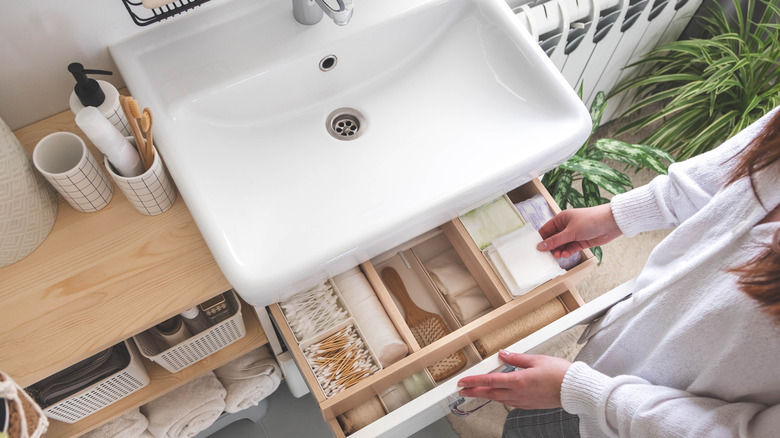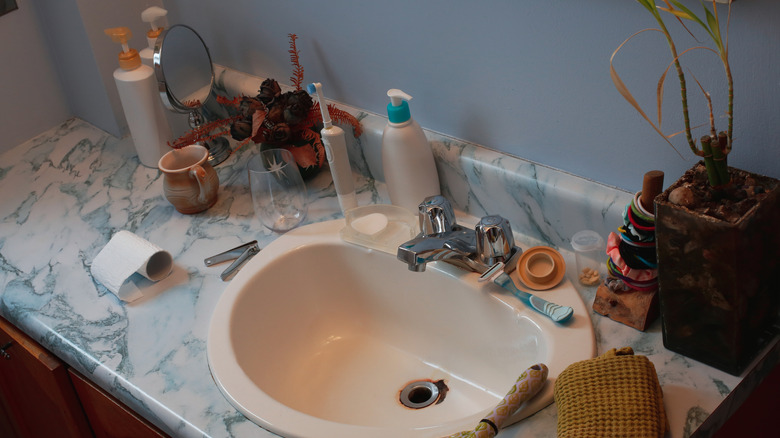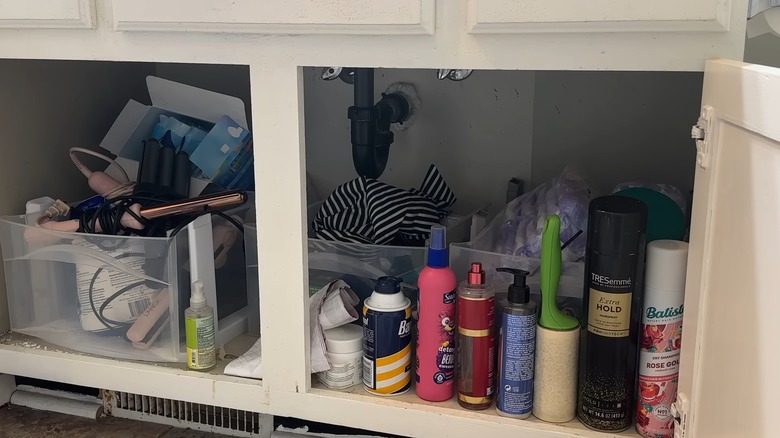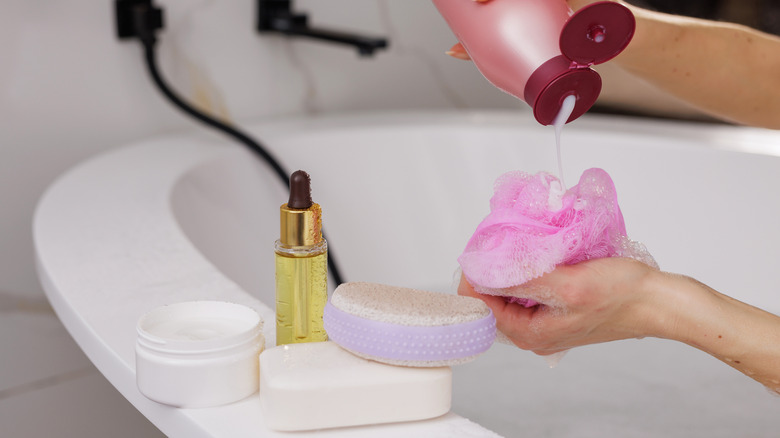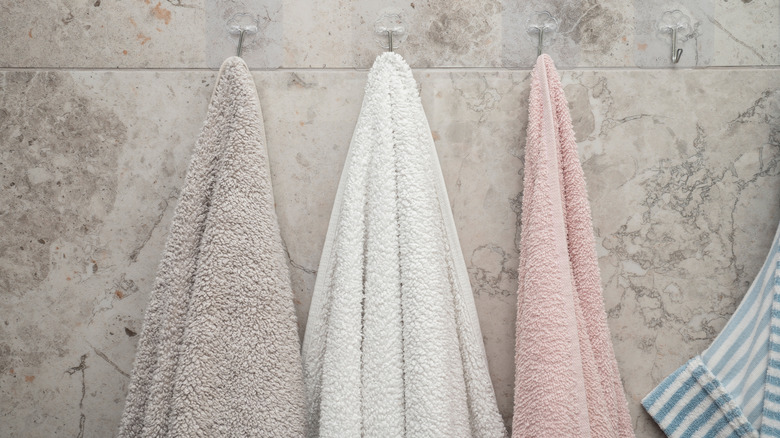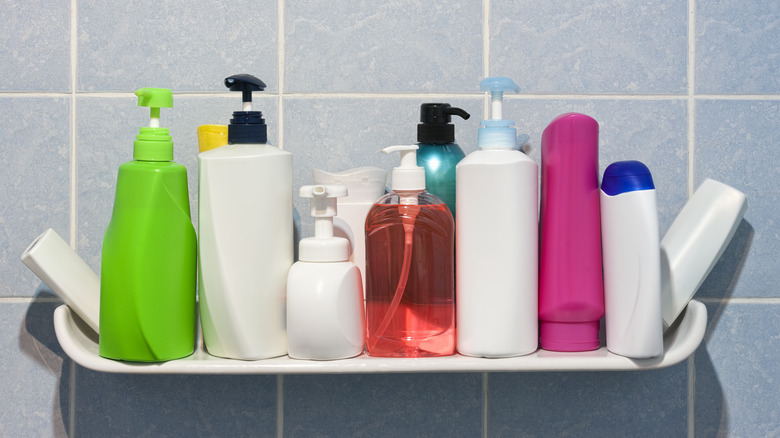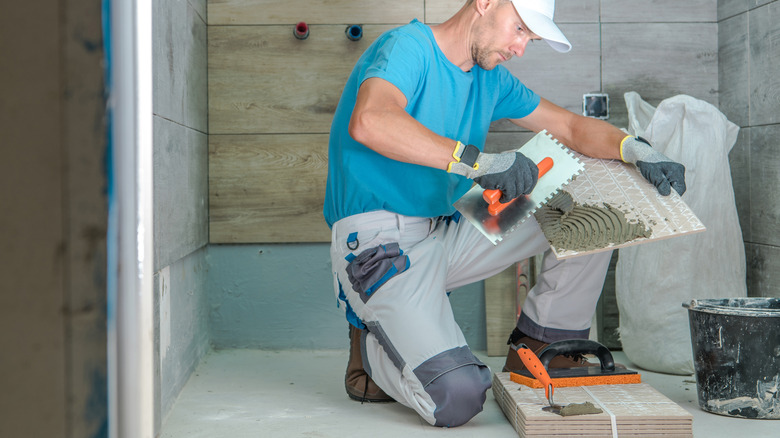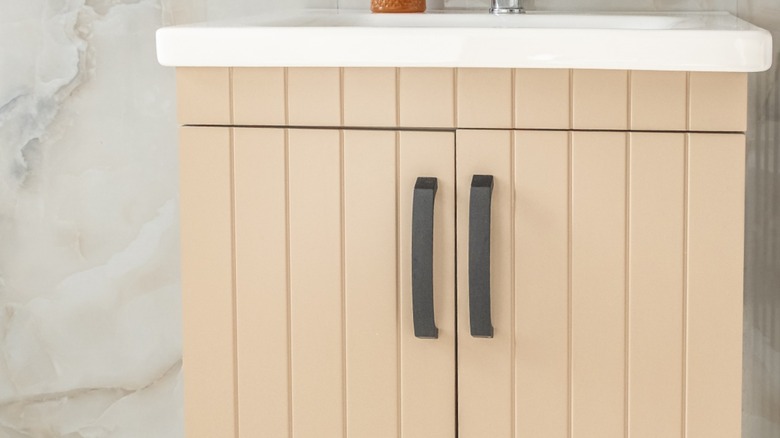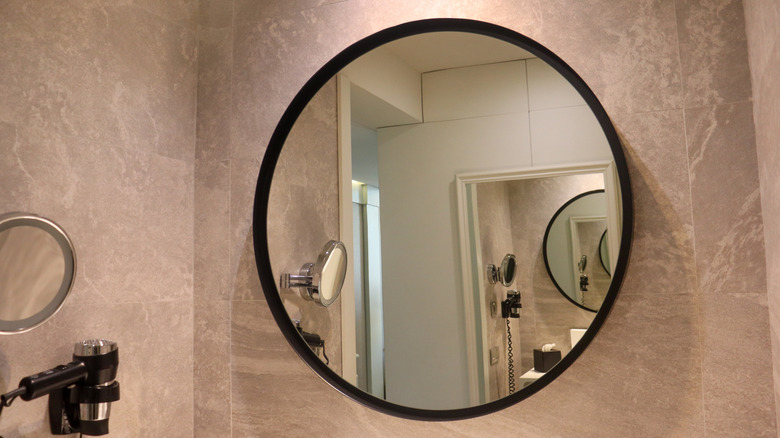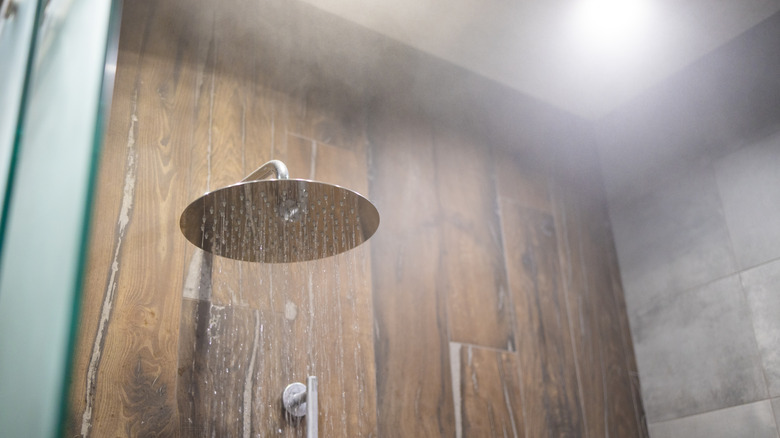Avoid These 10 Bathroom Storage Mistakes Everyone Makes
Trying to keep your bathroom's countertop or cabinet drawers organized might seem like an endless task. Add the chaotic area under your sink and you'll have an overwhelming mess on your hands. Sharing her thoughts on this, Cara Palmer, professional home organizer and founder of Organize Every Room, says in her exclusive House Digest interview, "The bathroom should be a place of rejuvenation rather than frustration over clutter and disorganization." So, what can you do to maintain a calming environment in your bathing chamber? Instead of taking a surface-level approach wherein you keep organizing the clutter every few days, go to the root of the problem and rectify your storage mistakes.
Don't worry, you don't have to undertake expensive adjustments. "Small, intentional changes to bathroom storage can dramatically improve functionality and create a more peaceful environment," admits Palmer. For instance, you should take advantage of the available vertical space instead of just sticking with horizontal surfaces. Similarly, don't throw items haphazardly in your drawers and cabinets. Categorize them and use dividers when necessary to keep things neat and tidy. To help you weed out and correct the 10 most common bathroom storage mistakes everyone makes, we spoke exclusively with five experts. Here's what they have to say.
You're not maximizing the available vertical space in your bathroom
Your bathroom's countertops, vanity drawers, and under-sink area are amongst the most convenient storage spaces. Unfortunately, they're the most cluttered ones, too. Now, you might argue that you don't have much spare room to keep them picture-perfect, but Palmer feels otherwise. She says, "Many homeowners focus solely on countertops and under-sink storage, neglecting the valuable vertical space in their bathrooms."
To rectify this storage mistake, get creative and look for available vertical areas, like corners, empty wall space, and the back of the bathroom door and cabinets. Then, invest in hooks, mounting racks, and hanging shelves to make the most of the limited space. Palmer suggests, "Install floating shelves or over-the-toilet storage units to utilize wall space. Tall, narrow cabinets can fit in tight corners while providing substantial storage." Once the countertop doesn't seem overwhelmed, add decorative touches, like plants. Have a little leftover wall space or an awkward corner? Make wall-mounted racks, slim caddies, and narrow rolling carts, like SPACELEAD's 3-Tier Storage Unit, your new best friends. "Over-the-door organizers or hooks can hold towels, robes, and toiletry bags. Consider installing small adhesive baskets inside cabinet doors for items like hair tools, makeup, or cleaning supplies," she recommends.
Emphasizing the importance of the space above your bathroom's door, Jodi Peterman, CEO and owner of Elizabeth Erin Designs, mentions in a House Digest exclusive, "This is a perfect place for a slim floating shelf to store extra towels or backstock items." In case you have tall ceilings, she advises, "...put a built-in cabinet over the door to store all the bulky things that you do not need to access on a daily basis."
Storing items in your drawers and under the sink without categorizing them
Do your drawers seem to get cluttered only after a few days of you organizing them? A lack of categorization might be to blame. Mindy Godding, a Certified Professional Organizer®, founder of Abundance Organizing®, and the president of National Association of Productivity and Organizing Professionals® (NAPO), agrees. She explains in her exclusive House Digest interview, "Even when contained, some groups can still feel visually cluttered because of the large quantity of small items in colorful packaging." Besides, the clutter will make it difficult for you to keep track of your purchases, making expired and duplicate products your new reality. Palmer elaborates, "Throwing everything under the sink without any organizational system leads to forgotten products and duplicate purchases."
To ensure you don't double-spend or have to throw out your products unnecessarily, empty all your storage solutions and carefully edit your belongings. Throw away the products you no longer use or ones that are past their prime. Categorize the remaining and store them accordingly in items you can use to organize your bathroom. Palmer suggests, "Group similar items together (haircare, skincare, first aid, etc.) in labeled bins or baskets. This makes items easier to find and helps track what you have and what needs replenishing." Don't categorize them randomly, though, or it would be hard to maintain the drawers. Sub-categorize the products and toiletries based on a system that's conducive to your lifestyle. For instance, if you have a different skincare regime for each weekday, store the products based on the day rather than sticking with broad categories. After you're done, label the baskets and bins to maintain this system. "We recommend opaque bins with labels for categories like medicine, first aid, and skin care," says Godding. The opacity of the bins helps further keep things looking organized, as clear bins, though still neater than no bins at all, can come across visually messy when you can see the contents inside.
Not using dividers to keep your bathroom drawers organized
Are you guilty of throwing your makeup, skincare products, jewelry, and hair accessories haphazardly in the vanity drawers? If yes, you're not the only one making this storage mistake. Speaking from experience, Godding shares, "The one bathroom storage mistake I see most frequently is that people have thrown items into their drawers without any structure or categorization." This will lead to your delicate necklaces getting tangled in your hair brush's bristles, or you spending precious time trying to find your favorite lipstick and bronzer.
Instead of spending your day locating or untangling items, Godding suggests using dedicated dividers. They'll keep your drawers organized and prevent the stored items from tangling together. She says, "Simple drawer organizers give items boundaries and contain like items for easy visibility and no dusty tangles!" You can get adjustable dividers, such as Utoplike's 4-piece Bamboo Adjustable Drawer Organizers, to create room for each type of item in your drawer. Otherwise, you can purchase clear dividers, like Vtopmart's 25-piece Plastic Trays, to improve visibility. You'll also have the flexibility to pick the right tray size for each item. For instance, you can assign slender ones to house your eyeliner and makeup brushes, and pick a broad one to comfortably store your face powders. However, if you'd rather not spend a lot of money on these tools, try DIY drawer dividers. Whichever way you go, ensure you have enough dividers to sort everything.
Ignoring the shower area and using the floor or the tub's edge to store bath essentials
Although you might not soak in your bathtub regularly, you might be using its ledge to store your bath products and related accessories. This can feel especially convenient if you have a shower-tub combo and lack a recessed shower niche. The shower's floor is another spot you may be using to place your toiletries. However, this storage mistake won't just visually clutter the space, but it can also be a potential tripping hazard. Just imagine how painful it'd be to slip on a pumice stone while shampooing your hair. Explaining why you shouldn't commit this faux-pas, Palmer mentions, "Shampoo bottles and bath products scattered around the tub's edge or shower floor create clutter and can be hazardous."
So, how can you double the storage space in your small bathroom? Palmer recommends, "Install a shower caddy, corner shelf, or tension rod system." You can go with whichever option you like, provided the organizer is rustproof. "For families, consider assigning each person their own caddy or shelf space," she continues. Basically, get an organizer with multiple (or tiered) shelves. Look for adhesive options, like YASONIC's 3-Pack Corner Adhesive Shower Caddy, if you rent your apartment. But if you don't need a lot of space save the essentials, she suggests, "Invest in wall-mounted dispensers for frequently used products like shampoo and body wash." You could even place a bathtub tray across the tub or position a stool near your bathtub to keep your bath bombs, Epsom salts, and essential oils within easy reach.
Improper towel storage leads to overcrowded hooks and attracts bacteria
In an ideal world, you'd have an endless supply of bath towels and never have to worry about their storage. Alas, hooks don't count, especially if you expect them to handle multiple pieces. Palmer agrees and mentions, "Insufficient towel storage leads to overcrowded hooks or towels that never fully dry." Besides giving off a musty smell, damp ones offer the perfect breeding ground for bacteria, viruses, yeasts, and molds. They can even cause fungal and viral infections, including athlete's foot and warts (yikes!). So, you must either wash them after every use to minimize infections or find ways to rectify this bathroom storage mistake.
For starters, Palmer suggests, "Provide adequate spacing between towel bars to allow proper air circulation." This will give them room to dry, so they won't remain damp the entire day. Install a dedicated bar, rail, or chic ladder to ensure you can spread the used ones instead of bunching them on a hook. The greater surface area will also speed up the drying process. Just avoid placing them near open windows to keep allergens from making themselves at home on your clean towels. Plus, improve your bathroom's ventilation, or "consider heated towel racks for quicker drying in humid environments." Avoid storing more than you need to declutter your bathroom and enjoy a more organized space. Finally, "For guest bathrooms, roll towels in baskets [with lids] for an organized, spa-like appearance that maximizes space," she mentions.
Failing to adapt to changing needs will add to your bathroom's clutter
Another storage mistake you might be making is not updating your bathroom's organization per your changing needs. For instance, you might no longer be sharing the space with your brother, so still making room for his grooming tools is unnecessary. Shedding light on this conundrum, Palmer mentions that most people set up a system, but fail to modify it. She says, "Setting up a storage system once and never reassessing it as needs change." You might also not be using certain products anymore or they might have gone bad. "Many bathrooms are cluttered with expired medications, half-empty bottles, or products that didn't work out," she explains.
The way out? "Review your bathroom organization seasonally. Adjust your storage as family needs evolve or as you switch to different products," highlights Palmer. To elaborate, set a decluttering schedule every few months and empty your organizers. This will give you a good idea of what you own, use, and no longer need. Adding to this, she mentions, "Check expiration dates on medications and cosmetics, and discard anything that's expired or hasn't been used in the past year. Set a 'use it or lose it' deadline for products you're unsure about." Apply a similar approach to your travel-size bath products and free makeup samples. To ensure you don't waste money on racks or caddies that won't keep up with your changing needs, she recommends investing in adjustable organizers. "Flexible storage solutions like adjustable shelving or modular containers can grow with your changing requirements."
Not thinking about integrated storage solutions while designing your bathroom
While designing your bathroom, your entire focus might be on the lights, the fixtures, and the furniture. Storage may not be at the top of your mind. However, this can prove to be a costly mistake. Echoing similar sentiments, Peterman says, "Storage in a bathroom should not be an afterthought. It should not be to add baskets and random shelving to the space after the fact, it should be thought about and designed in from the beginning." Essentially, you want to think about your storage needs while you have the chance to incorporate integrated solutions into your bathroom's design.
Though there's nothing wrong with using baskets, bins, racks, and caddies to organize and store all your bathroom essentials, they aren't as convenient or aesthetically-pleasing as integrated solutions. Explaining her vision, Peterman elaborates, "Recessed niches in the shower, toe kick drawers beneath the vanity, or a tall pullout storage tower that functions like a pantry can keep everything hidden away without sacrificing valuable floor space." This will ensure they're a seamless part of your bathroom and you won't have to keep investing in other storage solutions. Better yet, you get to customize the niches, cabinets, and vanities based on your tastes, preferences, and the available space.
Opting for a regular two-door under-sink cabinet instead of deep drawers
Two-door under-sink cabinets are a common bathroom staple. They might be your favorite, too. After all, you just have to place everything cluttering your otherwise Insta-ready countertop inside. The doors will stand sentry and hide the mess within. However, this is a major storage mistake according to Peterman. She says, "Those under-sink cabinets with just two doors? Total disaster zones. Shove everything in there, and before you know it, you are fishing expired products and a knotted ball of cords." This is because you'll probably forget about the items stored behind the doors and, before you know it, they'll fall through the cracks of your everyday busy life. If ignored for long, a cabinet might also become the ideal haven for dust, grime, cockroaches, and rodents.
The solution? "Deep drawers with built-in dividers, pull-out hampers or dedicated styling tool storage with outlets make a big difference in being usable," opines Peterman. You won't have to compromise on space and the integrated organizers will keep all your bathroom essentials sorted, from makeup and bath products to towels and grooming tools. This also means you won't have to deal with tangled cords, expired products, and a family of pesky pests. Alternatively, if you want to add a little personality to your bathroom, check out your local thrift store or attend a few estate sales to score an antique dresser at a discount. "Transforming a vintage dresser into a vanity is a game changer — the deep drawers are far more practical than the shallow drawers found in most vanities," she adds. With that said, you'll need to set aside significant time and put in considerable effort to clean, polish, and overhaul the old dresser.
Overlooking the potential of hidden mirrored medicine cabinets
A mirror is one of the most important bathroom accessories. How else will you get ready for the day or follow your nine-step nighttime skincare regime like David Rose? But you might be overlooking its storage potential by using it as a mere looking glass. Peterman feels the same and mentions, "A plain mirror is fine, but if storage is an issue, that wall can become a workhorse instead."
So, what do you do to maximize their storage potential? Peterman suggests, "Replace a basic mirror with a custom mirrored cabinet with hidden storage by replacing the sliding or lift-up panels. It puts all those daily-use toiletries where you need them without adding clutter to the counter." Experiment with the mirror's shapes and sizes to add a fun element to your bathing room. Play around with varied ideas, like sliding mirrors (similar to barn doors), hinged ones, or one that opens outward or upward.
If you're not in the mood to spend a lot of money on designer solutions, create a hole in your drywall and build a custom shelf to DIY a hidden medicine cabinet mirror. Another option is to insert them into nooks in the wall so the mirror is flush with the wall. Rachael Fahncke, CEO and founder of Dayton Designer Closets, explains in her exclusive House Digest interview why these corners work: "Nooks fit easily between studs in your wall and can be open, closed or hidden — what is great about nook storage, is that it can easily be added to an existing bathroom that's lacking storage or style."
Thinking a bathroom's humidity levels won't affect storage
Bathing chambers are infamous for having high levels of humidity, courtesy of the shower, tub, and sink in the room. However, you might forget about it when installing organizers. Opening up about this mistake, Cole says, "Bathrooms need to be designed with humidity in mind, but some people don't think this extends to storage too. I have too often seen things like wooden shelving without proper seals, which will warp over time. Even things like metal, which will rust with the humidity." To illustrate, a wood-based cabinet might expand due to the vapor in the air and contract once it's dry. This will start a vicious cycle, warping the cabinet over time.
So, you must carefully choose the material in your bathroom to ensure you get a high ROI (return on investment). Listing the materials that can withstand the space's humidity, Cole mentions, "If you want to avoid this, stick to things like metal, glass, or plastics that are actually designed to handle the moisture." That being said, ensure all metal organizers are water-resistant or have a rust-proof coating. You also don't have to bid wood goodbye. Solid wood, melamine, plywood, and MDF are a few types of wood that will hold up to the humidity in your bathroom. In case you have recently installed a few storage options and don't feel like swapping them out, try improving the room's ventilation to control its humidity. Keep the window(s) open, determine the best type of fan for your bathroom, and wipe all nearby surfaces after you take a shower, soak in the tub, or wash your hands at the sink.
